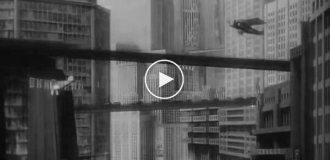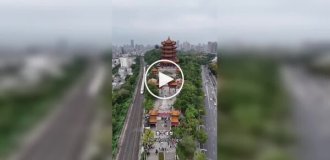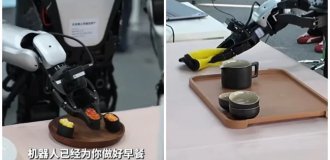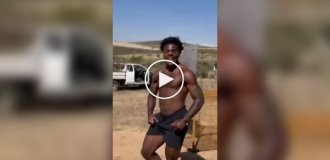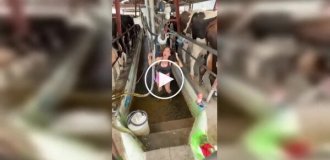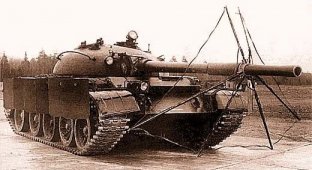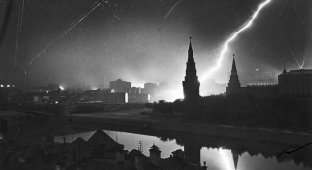Pershing vs Panther. The last battle of the Cologne Panther: a unique newsreel (9 photos + 1 video)
For a good soldier, luck is to be in the right place with the right weapon; for a documentarian, it is to pick up a camera at the right time. In the case of the tank battle that took place at the end of the war in Cologne, these circumstances coincided.
A unique newsreel captured a tank battle where the stubborn crew of a German Panther confronted an American Pershing. This footage was captured by US Signal Corps Sergeant Jim Bates.
Burnt out Panther tank near Cologne Cathedral, March 6, 1945.
More than 70 years ago, in Cologne, a tank duel took place between the German Panther tank, which had previously destroyed the Sherman tank, and the American Pershing. On March 6, 2015, on the anniversary of this battle, 'Die Welt' publishes an article in which Sven Kellerhof answers the question: was there even a tank duel or was it all staged? He writes: “Photos of the battle between the German Panther tank and the American Pershing on March 6, 1945 are suspected of falsification. But independent scientist Dierk Lürbke believes that this is in vain.”

Sgt. Jim Bates, a First Army Signal Corps
On March 6, 1945, the US 3rd Tank Division fought in the city of Cologne, developing an offensive towards the Rhine. Sergeant Jim Bates of the First Army Signal Corps was sent to cover the events in 3 TD. The duties of the Signal Corps, in particular, included describing the course of battles first-hand. Bates had a 16mm movie camera with him, with which he shot the famous newsreel. The film itself is not big and is interesting with real scenes of street fighting. However, the real glory of the film was brought by 48 seconds of the most low-quality, but most interesting footage about the battle of American tanks with the Panther tank in front of the Cologne Cathedral. It is this fragment that will be discussed in detail in the article. Although Bates's camera often shakes during the film, loses focus, and goes off-focus during street battles, Jim Bates was awarded a Bronze Star for the film.

At noon on March 6, 1945, the city center of Cologne, the once proud Rhineland metropolis, consisted only of shot-up, burnt-out, collapsed buildings. The cathedral's two towers were also damaged. Yet there was danger in the wreckage, as it offered excellent cover to enemy soldiers. Therefore, Company 'F' of the 32nd Tank Regiment was careful when advancing into the city center: two Shermans covered their path along Komödienstraße towards the Rhine.
The American motorized infantry advanced at a slow pace. Shortly after 2 p.m., large piles of debris blocked the further path of the two tanks. They stopped to wait for the engineering troops with heavy equipment. But suddenly two shells hit the right Sherman, which immediately caught fire. Three of the five crew members died instantly or died some time later. A German Panther tank fired from the ruins of Cologne Main Station.
As they advanced toward the city center of Cologne, the American soldiers were accompanied by several war correspondents: Mike Levin of the Overseas news service, Eric Schwab of the French news agency AFP, Alan Jackson of the International News Service, and photographer Fred Ramage (Fred Ramage), and several operators, such as Jim Bates.
With many reporters on the scene, the Sherman's hit was extensively documented—and what followed. The ensuing battle, due to the unusually large number of images, became known internationally as the "Tank Duel in Cologne". But was there any confrontation at all? Or is this staged?

So, as they fought their way toward the city center, American troops came close to the famous Cologne Cathedral, the pearl of German and world architecture. At the foot of the majestic Gothic building, the daily small tragedy of the great war played out. The tall cathedral building in the center of Cologne noticeably dominated the rest of the buildings and therefore the American troops made their way there. The advance detachment of Americans began to enter the square in front of the Cathedral along Comedien Street, adjacent to the Church of St. Andreas. At the end of the street, at the intersection of Marcellan Strasse, in front of the Cathedral, the Americans suddenly saw the Panther. However, the enemy tank did not show any signs of life, so the Americans decided that it had been abandoned by the crew. However, the crew in the Panther was very determined. When the leading Sherman approached the Panther, the Panther knocked him out with the first shot, almost point-blank. Three crew members died inside the American tank and a fire started, but two tank crews still managed to get out of the turret. One of them had his right leg torn off and he rolled backwards through the engine compartment. The second surviving tanker rolled down the starboard side. Tankers from another Sherman, who was stationed to the left, at the corner of the alley, came to the aid of their injured comrades.

A problematic situation loomed for the Americans, because the Sherman gun could do virtually nothing with the Panther's frontal armor, while the Panther could confidently knock out the M4 anywhere.
However, at that time, the 3rd TD included new American M26 tanks with a powerful 90mm cannon and thicker armor. These new products arrived in Europe less than a month ago to undergo front-line testing as part of Operation Zebra.
Along the streets Gereonstrasse and An den Dominikanern, which run almost parallel to Komedinstrasse, soldiers of the "E" branch of the 32nd Tank Regiment simultaneously advanced. At the head was a heavy American tank of the new type "Pershing", one of the few. The tank was almost the same in size as the Panther, but was more heavily armed with a 90mm cannon, albeit a slightly slower one. However, this made no difference in street battles.

Pershing tank commander Robert Early knew he had to fire on the German tank as quickly as possible. The bridges over the Rhine had already been blown up, so retreat was impossible for the Panther crew. They would fight as long as there was ammunition or until they were shot down, or so the American soldiers had to assume.
Robert Earley left his car to assess the situation, cameraman Jim Bates accompanying him. After some searching, they found an ideal observation post in the former home of the German fascist organization "Deutsche Arbeitsfront" at the Marzelenstrasse intersection. This is where Bates set up his camera. Just 120 meters away, at the end of Marzelenstrasse, the Panther took up a position behind a large pile of rubble, waiting to take out the next American armored vehicle that came along Kommedinstrasse.
Robert Early did not want to allow this - he ordered the Pershing to move. A little later, a heavy tank appeared at the intersection. The German opponents apparently realized that something was happening to their right; in any case, they turned the tower. Only the one who shot first had a chance. But the Panther's commander, Oberleutnant Wilhelm Bartelborth, hesitated: the other tank did not look like the Sherman. Or maybe this is a German car?
American tank gunner Corporal Clarence Smoyer recalled:
“We were lucky that our M4 was replaced with an M26 Pershing with a 90 mm cannon. We advanced to capture Cologne and were near the center of the square in front of the cathedral when one of our tanks, an M4 Sherman, approached the central square and was hit by a German Panther. Three tank crews were killed. When this happened, our crew was ordered to drive down the next street and destroy the German tank. It was necessary to get to the intersection so that we could shoot at the side of an enemy tank, whose gun was facing another street.”
When the Pershing entered the intersection, the driver saw through the periscope the Panther's gun, which was turning towards his tank. To avoid becoming a stationary target, the Pershing jumped into the middle of the intersection.
The gunner recalls that he fired the first shot while moving:
“Then we stopped and I fired two more times to make sure they didn’t open fire on us. All three of our shells penetrated the armor: one under the gun mantlet and two on the side. Two shells went completely through the side and flew out on the other side. It is clear that none of their crew survived this ordeal."
The corporal was right about the number and locations of hits, but he was wrong about the German tank crews. Judging by the unclear footage, three or four crew members managed to escape the stricken Panther. Their further fate is not known with certainty, as are their names.

All that remains is 46 seconds of exclusive war newsreel - the last battle of the Cologne Panther.
Thanks to Dirk Lurbke's careful research, despite other claims, it is now clear: documentaries and books are not some kind of staged images. This is the reality that happened on March 6, 1945, in the piles of rubble that was Cologne at the time.
The Americans inspect the Panther tank.

An American aerial photograph taken on June 22, 1945 shows a new location where the downed Panther was dragged - closer to the station.
The panther is visible in the center of the orange circle.

A damaged Panther in a new location - near the station.
A damaged Panther near Cologne train station. On the upper frontal plate there are traces of hits from 13 shells. The shelling is carried out after the battle.
The only visible damage is a broken driver's inspection hatch lying in front of the tank.
After the battle, the American tank crews decided to test the strength of the frontal protection of the tank they had recently destroyed. This was not an official test, but in light of the recent fight, their interest is understandable. It’s one thing to fight in the field and another thing to fight in the city, when you can’t miss each other. In order not to walk too far, the burned-out Panther was towed about 150 m, placed to the right of the entrance to the station and fired upon. Judging by the photographs, the Americans were interested in the strength of the upper frontal plate. They shot 13 times - caliber, sub-caliber and
land mine. Not a single shell penetrated or split the German armor. However, one hit by an armor-piercing shell hit the very edge of the driver's inspection hatch. Perhaps this was the reason why
the hatch was torn off and fell in front of the tank. No other serious damage is visible. Naturally, these details were not included in the newsreels.

